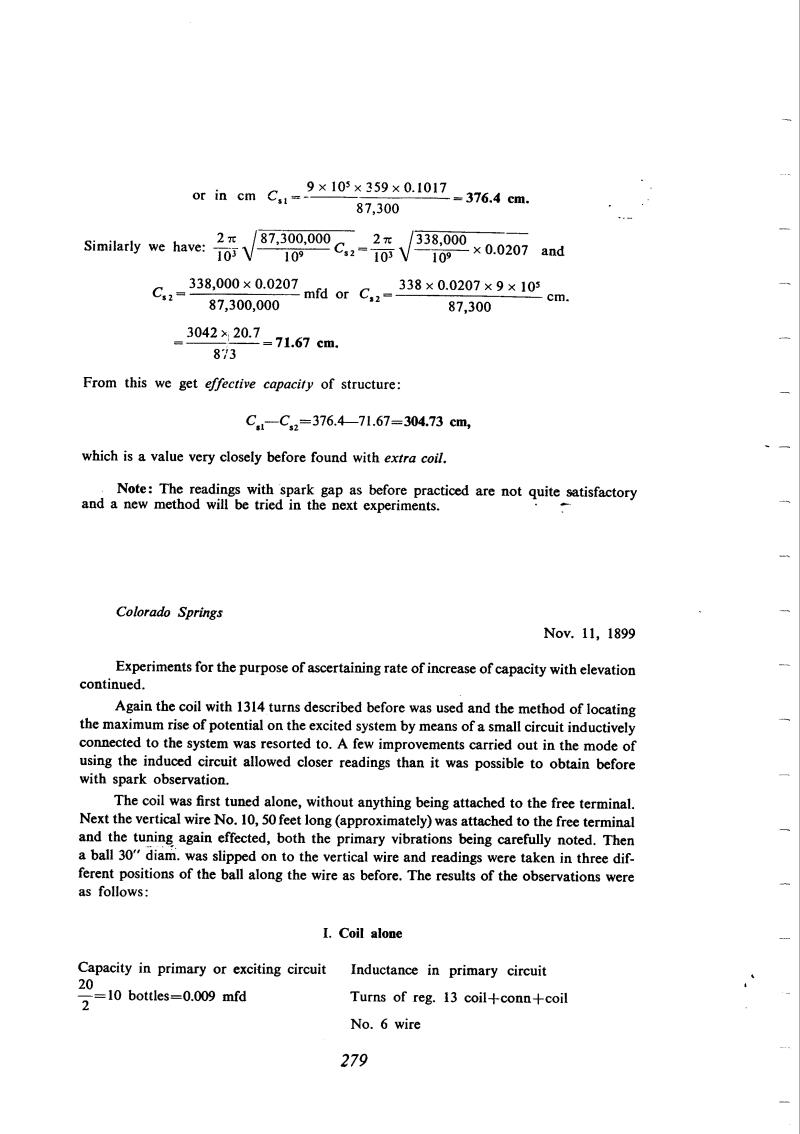
Nikola Tesla Books
or in cm Cs1 = $! {{9 \times 10^{5} \times 359 \times 0.1017} \over 87,300} $! = 376.4 cm.
Similarly we have: $! {{2 \pi \over 10^{3}} \sqrt{{87,300,000 \over 10^{9}} {C_{s}}_{2}}} $! = $! {{2 \pi \over 10^{3}} \sqrt{{338,000 \over 10^{9}} \times 0.0207}} $! and
Cs2 = $! {{338,000 \times 0.0207} \over 87,300,000} $! mfd or Cs2 = $! {{338 \times 0.0207 \times 9 \times 10^{5}} \over 87,300} $! cm.
= $! {{3042 \times 20.7} \over 873} $! = 71.67 cm.
From this we get effective capacity of structure:
Cs1 - Cs2 = 376.4 - 71.67 = 304.73 cm,
which is a value very closely before found with extra coil.
Note: The readings with spark gap as before practiced are not quite satisfactory and a new method will be tried in the next experiments.
Colorado Springs
Nov. 11, 1899
Experiments for the purpose of ascertaining rate of increase of capacity with elevation continued.
Again the coil with 1314 turns described before was used and the method of locating the maximum rise of potential on the excited system by means of a small circuit inductively connected to the system was resorted to. A few improvements carried out in the mode of using the induced circuit allowed closer readings than it was possible to obtain before with spark observation.
The coil was first tuned alone, without anything being attached to the free terminal. Next the vertical wire No. 10, 50 feet long (approximately) was attached to the free terminal and the tuning again effected, both the primary vibrations being carefully noted. Then a ball 30" diam. was slipped on to the vertical wire and readings were taken in three different positions of the ball along the wire as before. The results of the observations were as follows:
| I. Coil alone | |
| Capacity in primary or exciting circuit $! {20 \over 2} $! = 10 bottles = 0.009 mfd |
Inductance in primary circuit Turns of reg. 13 coil + conn + coil No. 6 wire |
279
November 10
Had Tesla published the measuring methods he developed in New York and Colorado Springs, his name would probably be frequently encountered in earlier textbooks and handbooks on electrical measurements at high frequencies. As it is, we can only remark his exceptional ingenuity in designing measuring devices and the accuracy with which he determined the resonance of oscillatory circuits. An especially interesting feature is his method using a lamp already heated up by a supplementary power source, greatly increasing its sensitivity to small amplitude changes around the resonance peak of the oscillatory circuit.
November 10
He winds a new coil with 1314 turns on the same core on which he wound 689 turns (please see Oct. 18) and later 346 turns (please see Oct. 31). With this coil he measures the metal sphere capacitance again and achieves a similar value as on November 7, with "additional coil". At the end of these measurements and calculations he establishes that the method of resonance determination on the basis of spark length in the arc gap is not quite satisfactory. In the following experiments he changes the resonance determination procedure. He returns to a method which he applied earlier in the New York laboratory. That method was based on the use of an auxiliary secondary coil, in a weak inductive link with excitation system, at which terminal is the instrument for the registration of current or voltage change in the secondary. usually for the registration of changes a small bulb was used. The variation of the method is particularly interesting where the small bulb is preheated by means of a D.C. current (please see Fig. 2). The preheated bulb could register very small excitation changes from the high frequency direct current circuit, which are applied to additionally heat up the already preheated filament in order to emit visual light.
By using the newly applied method of resonance indication he performs some measurements again and he measures the capacitance of a vertical wire 50 ft. in length. After this he switches over to determine the coil self-capacitance with 1314 turns. The measured result he compared with the calculated one for the capacitance of a metal cylinder of the same shape as the coil. According to Tesla, this serves only as a rough estimate. When they are using the entire coil length in the first calculation, he obtained a higher value than measured, he takes the effective coil length on the basis of bare wire. It is obvious that Tesla looks for orientation of the theoretical equations in order to be able to estimate parameters, but the experiment is the most effective factor. As far as the problem of determining the coil self capacitance, this is evident from the first days of the notes (please see eg. June 20, July 3, etc.)
November 11
In measuring the capacity of a sphere at different heights Tesla here uses a loosely coupled circuit containing a lamp to determine resonance. The results for a 50 ft wire differ somewhat from those of October 28th, but are within the limits of error of the method. The values for the capacity of the sphere are somewhat higher than before, but not in proportion to the diameter of the sphere.
November 11
He continues for measurements of the sphere capacitance changes at various elevations above the ground. For the purpose of determining the resonance he uses the circuit weakly coupled with the bulb. The results for the wire 50 ft. in length are somewhat different from those obtained Oct. 28, but the differences are within the limits of measurement accuracy. The values for the sphere capacitance are somewhat higher than previous, but they are not increased proportionately in relation to the sphere diameter.

